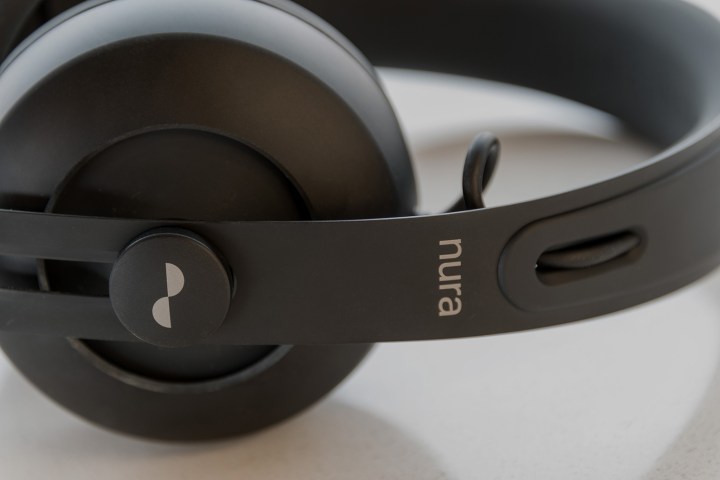“The Nuraphones probe your ears to customize their sound, and the results are remarkable.”
- Machine learning personalizes sound quality
- App is easy to use
- Excellent audio quality
- Finding a comfortable fit can be difficult
No matter how good a pair of headphones is, and no matter how much care goes into the engineering and design, the simple truth is your own hearing capabilities play a huge role in your experience with them. Nura’s Nuraphone headphones have been crafted with the aim of adapting audio playback to your own hearing, incorporating novel technology and a hybrid in-ear-meets-over-ear design for better sound.
Performance
The big draw here is the ability to adjust the sound equalization to your hearing. The Nuraphone use otoacoustics emissions (OAE), a phenomenon produced within the cochlea — the organ located in the inner ear that changes waves entering the ear into the signals sent to the brain — to “learn” and adjust to your hearing ability. The brand claims the headphones then sonically “mold” the sound signature for the best possible sound quality.
The process is interesting: The Nuraphone’s drivers play a range of different tones, sending sound to the cochlea, wherein three tiny bones vibrate and convert the sound into signals that are sent to the brain. But the vibration also reverberates back through the ear canal to the eardrum, which acts as a “speaker,” emitting those tiny OAEs. The Nuraphones pick up those OAEs, and then an app adjusts the playback EQ (the app will be available for both iOS and Android devices). This information is then saved on the app, which can store up to three separate profiles. Once that data is stored, the headphones are said to able to automatically recognize who is wearing the headphones.
While the process sounds technical, in practice it couldn’t be simpler. All that you need to do is put on the Nuraphones, connect them to your device, and download the app. After a couple simple on-screen prompts, the sonic molding process begins. In total, it lasted about one minute. Once complete, the app begins playing a song, and gives you to option of swapping between the “normal” unchanged sound, and the personalized EQ.
Their big selling point – the ability to re-tune the headphones to your hearing – works impeccably.
The change is remarkable. Out of the box, the Nuraphones sound decent enough, though a little gutless. Once the EQ had been modified to suit our hearing, the true quality of the Nuraphones revealed itself. The bass is wonderfully detailed, and the overall mix felt rounded and comfortable. For our ears, it was a massive upgrade, and the difference was noticeable not just between the Nuraphone’s own playback modes, but when compared to other headphones, too.
On the connection side of things, users have a few options: The Nuraphones can handle both wired and wireless connections, supporting Bluetooth with AptX and AptX HD for Android users, and features a 20-hour battery life when used wirelessly.
Wired connectivity includes standard 3.5mm connection as well as Apple Lightning, USB-A, USB-C, and micro-USB connection.
We used the Nuraphones almost exclusively over Bluetooth, and never experienced any interruptions, distortion, or drop outs.
A USB-A cord is included in the retail package, while other cables can be purchased optionally. In addition to the Nuraphone and USB-A cable, the Nuraphone also ships with a magnetically sealed carrying case.
A software update since the headphones initially launched has enabled the Nuraphones to have ambient awareness and active noise-canceling modes, in addition to enabling buyers to set-up multi-press commands on the two touch buttons. We updated a pair of Nuraphones to the new software and were impressed with the new features. Though we wouldn’t put the noise reduction of the headphones on par with similarly priced noise-canceling options from Bose or Sony, they still noticiably reduced background noise in our busy open-air office.
Comfort and design
Performance isn’t the only noteworthy aspect of the Nuraphones. The headphones are designed as a hybrid between in-ear and over-ear headphones. According to Nura, this design channels midrange and treble frequencies to the inner-ear portion of the headphones, while the over-ear section delivers bass via physical vibration through your skin, which the company says prevents any one part of the mix overpowering another, and allows users to adjust the sound isolation through the app.

From our time with them, we found the sound isolation to be nearly complete. However, the hybrid in- and over-ear design took some getting used to. The in-ear pieces are held in place with hard plastic that can be uncomfortable if not angled correctly. Unfortunately, we never found the perfect fit for us, but your mileage may vary – just like hearing, everyone’s ears and heads are shaped differently, so comfort is subjective. That said, we’d take a slightly more finicky fit with excellent sound over a comfortable yet-placid pair of headphones any day.
Conclusion
The Nuraphone’s big selling point – the ability to re-tune the headphones to your hearing – works impeccably. It’s simple, fast, and makes a surprising difference. They might not be the first headphones to do this, and we have some misgivings about the comfort, we can’t help but recommend checking them out. At $400, they are peeking into the more expensive end of headphones (though there are audiophile-grade models that are easily multiple times that price) but from our time with the Nuraphones, we have to say they definitely seem worth the asking price.
You can learn more about the Nuraphones at Nura’s official website.
Update: The company has enabled active noise cancelation and ambient awareness via a software update. By Parker Hall.





